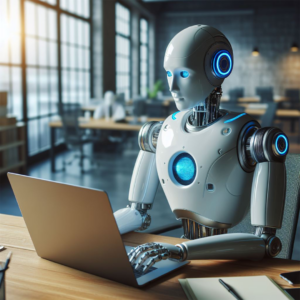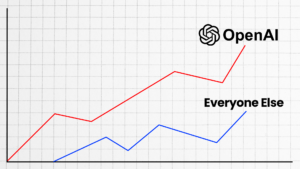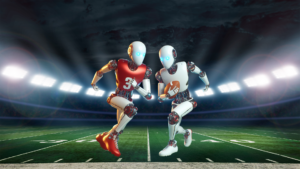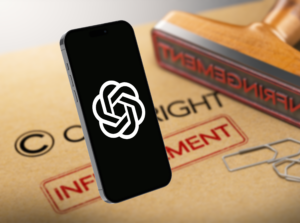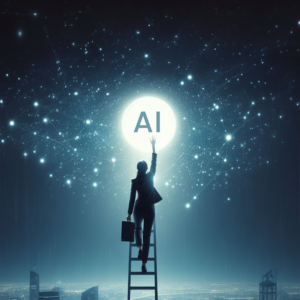In recent years, the ever-evolving landscape of technology has given rise to groundbreaking advancements in artificial intelligence (AI). One such field that has significantly benefited from AI’s prowess is User Experience (UX) and User Interface (UI) design. As businesses strive to create seamless and intuitive digital experiences, AI has emerged as a game-changer in the design process. In this blog post, we will delve into the transformative impact of AI on UX/UI design and explore how it streamlines workflows, enhances creativity, and elevates user satisfaction.

I. Understanding the Role of AI in UX/UI Design
AI’s integration in the UX/UI design process goes beyond automating repetitive tasks. Its capabilities extend to analyzing data, predicting user behavior, generating creative solutions, and refining designs. This newfound synergy between human creativity and AI-powered intelligence has revolutionized how designers approach their work.
II. Data-Driven Insights for Enhanced User Understanding
AI has empowered designers with an unprecedented level of user understanding by analyzing vast amounts of data. Through machine learning algorithms, designers can gain deep insights into user preferences, behaviors, and pain points. With this data-driven approach, UX/UI designers can make informed decisions, design personalized experiences, and optimize interfaces for higher user engagement.
III. Rapid Prototyping and Iterative Design
Gone are the days of long and laborious prototyping processes. AI-driven tools enable rapid prototyping, facilitating iterative design cycles. By harnessing AI-powered software, designers can quickly generate and test multiple design variations, obtaining real-time feedback from users. This iterative approach ensures the final product aligns precisely with user expectations and business objectives.
IV. Natural Language Processing (NLP) for Voice User Interfaces (VUI)
The rise of voice-controlled devices and virtual assistants has put VUI at the forefront of UX/UI design. AI’s natural language processing capabilities enable designers to create intuitive and responsive voice interactions. From understanding user commands to generating contextually relevant responses, NLP-driven VUI design enhances accessibility and user satisfaction.
V. Empowering Creativity with AI-Driven Design Assistance
AI augments human creativity by offering design assistance tools that inspire fresh ideas and streamline the design process. AI-powered design assistants analyze user preferences, industry trends, and aesthetic elements to suggest innovative design solutions. This symbiotic collaboration between AI and designers fosters a more dynamic and imaginative design process.
VI. Personalization at Scale
Personalization has become a cornerstone of exceptional user experiences. AI enables designers to implement personalized content, layouts, and interactions, catering to individual user needs and preferences. By tailoring interfaces to specific user segments, businesses can enhance customer loyalty and drive engagement.
VII. Streamlining Collaboration and Workflow
AI-powered project management tools simplify collaboration among designers, developers, and stakeholders. These tools automate task allocation, track progress, and analyze data, streamlining the design workflow. By reducing administrative burdens, designers can focus on creativity and problem-solving, leading to more efficient and impactful projects.
VIII. Aiding Accessibility and Inclusivity
Inclusive design is paramount in creating products that accommodate users with diverse needs. AI-driven accessibility tools help identify potential barriers and suggest design improvements to ensure an inclusive user experience. From color contrast analysis to voice-enabled interfaces, AI empowers designers to create products that resonate with a broader audience.
IX. Predictive Analytics for UX Optimization
AI’s predictive analytics capabilities enable designers to anticipate user behavior and preferences, even before a product’s release. By leveraging AI-driven data analysis, designers can make data-backed decisions to optimize UX/UI elements and deliver more satisfying user experiences.
Conclusion
The integration of AI into the UX/UI design process marks a transformative era in digital design. From data-driven insights to creative assistance, AI empowers designers to craft more intuitive, personalized, and accessible user experiences. By leveraging AI as a collaborative partner, designers can unlock their full creative potential and deliver exceptional digital products that captivate users and drive business success.
In embracing the potential of AI-driven design, the future of UX/UI design holds exciting possibilities, ensuring that technology continues to evolve hand-in-hand with human ingenuity. As AI continues to advance, the role of designers will remain central, merging intelligent automation with the human touch to craft memorable digital interactions for users around the globe.
If you want to take your UX/UI design to the next level, let us help you take the first step!


